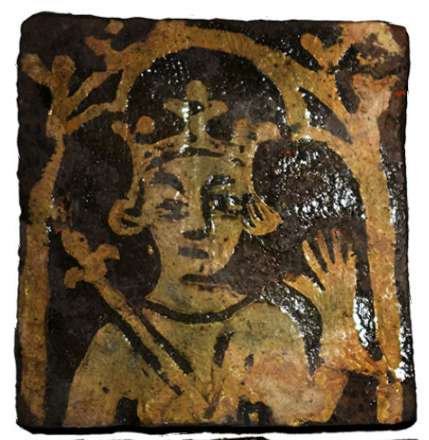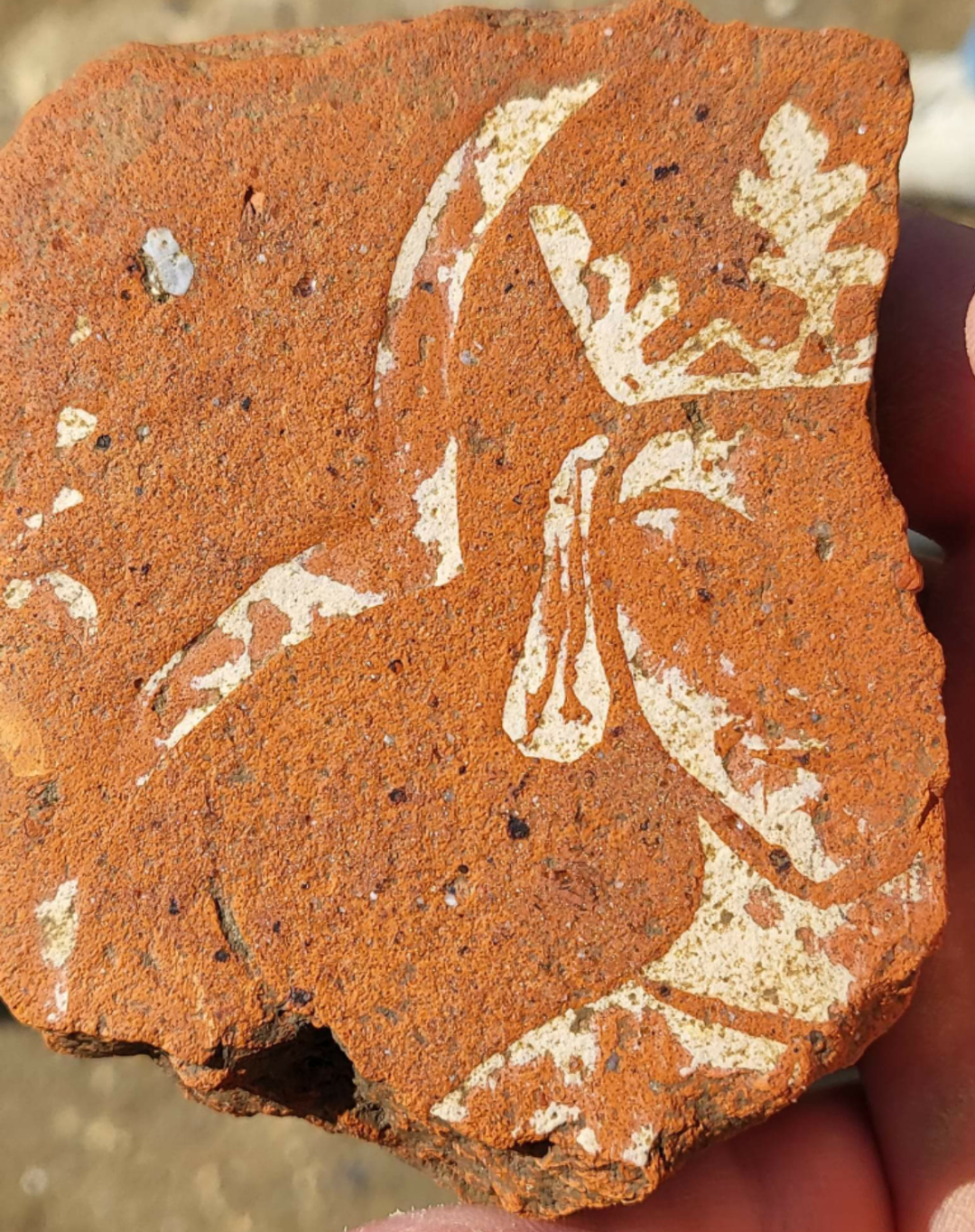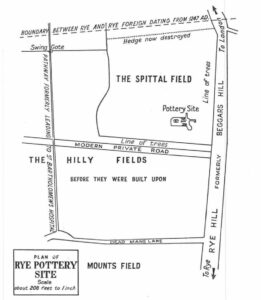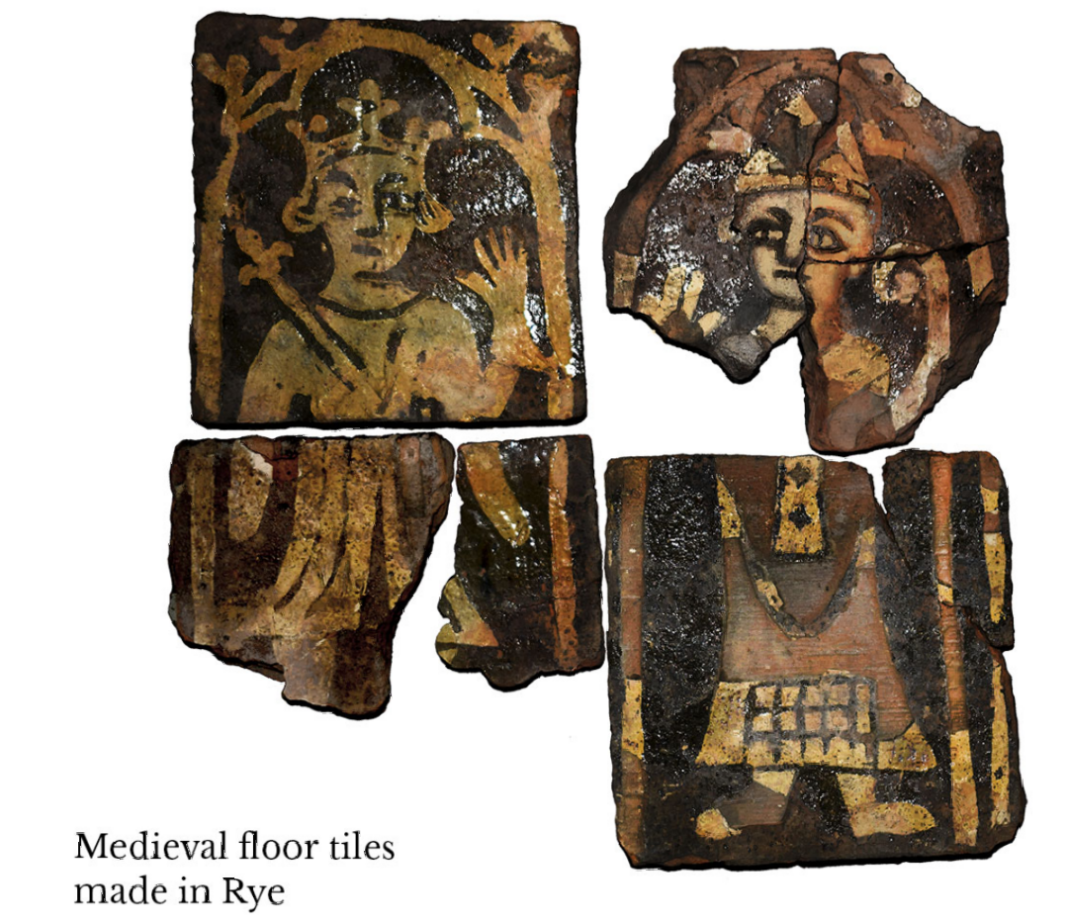The latest in the series on objects from Rye Castle Museum and what they tell us about the history of Rye and the surrounding area.
Medieval floor tiles made in Rye chosen by Penny Bruce who works at Rye Castle museum
In Rye Castle are several medieval floor tiles found, along with four medieval pottery kilns, in 1931 and 1932 in Rye by the historian Leopold Vidler. Amongst tiles showing designs and images of animals are four showing two figures, one believed to be King Edward I ,who reigned from 1272-1307. The king is pictured in two tiles: the the upper showing the king, without a beard and crowned and the second showing the lower half. The other pair of tiles depict an archbishop wearing chasuble and alb with his hand raised in blessing and holding a crosier, thought to be the Robert Winchelsey (or Winchelsea) who was the Archbishop of Canterbury from 1293-1313.

Penny Bruce explains why she has chosen these objects:
“I am currently working in the office at Rye Museum and also as a finds assistant at the excavation of Lossenham Priory in Newenden. I have chosen the four medieval floor tiles at Ypres Tower, as I am interested in medieval floor tiles and am particularly drawn to the two figures depicted that of a king and a bishop. The tiles are decorated in pale yellow slip and the image of the king is similar to images found on coins of the same period (13th century). During recent excavations at Lossenham a similar image of a king was discovered on a tile fragment. Fragments of medieval pottery from Rye kilns have been recorded at Lossenham and this tile fragment may form part of that connection between Rye and Lossenham Priory.”

Kilns and pottery discovered
Leopold Vidler had set out to find the site of the leper hospital of St Bartholomew’s, built around 1189 by the monks of the Benedictine Abbey of Fecamp in Normandy. Rye at that time was part of the Saxon manor of Rameslie, promised to the Normans by Aethelred II in the early 11th century and finally given to them by Cnut (Canute) in 1017. In the following centuries the ownership of the land changed hands between the French and English until after Henry V’s victory at Agincourt, when it stayed in English hands, but by 1435 the hospital was in ruins.
The exact location of the hospital is unclear but the historian William Holloway in his Antiquarian Rambles Through Rye of 1866 identified the site to be Spittal Field on the west of Rye Hill. Leopold Vidler agreed and in 1931 he set about trying to find the remains of it in this field.
Very soon after opening a trench in the corner of the field, Vidler made his amazing discovery: the remains of a medieval pottery kiln along with the remnants of the pottery it produced. Here is his account of the initial discovery, from his article ‘Floor tiles and kilns near the site of St Bartholomew’s Hospital, Rye’ from the Sussex Archaeological Collection vol LXXIII:
“For the first 18 inches, the soil was clean mould with occasional pieces of old churchwarden pipes, then I came on to soil packed with small pieces of very uninteresting pottery, and as I got down the pieces got larger and of a better type, until at about 5 ft. I came on a hard baked surface of clay. Thinking I was in a rubbish pit, where broken pots and ashes had been thrown, I started trenches first east and then north, hoping to strike the foundations, but the rubbish gradually petered out in both directions. I then extended my first trench, and made the discovery of a double arched opening with the arches intact, full of pots and fragments of pots, burnt ashes and soil all mixed in utter confusion. Suspecting the opening of a drain, I cleared it back to the arches and beyond, and found a whole pot built in to the structure. From then there was no longer any doubt that I had stumbled on a pottery kiln. After clearing the two tunnels, which gradually rose, for some 4 ft. I turned my attention to a hole on the left literally packed with pottery. Soon after a few pieces of broken inlaid floor tiles began to come out.”
The kilns (three more were later found), pots and tiles were all made from the clay found on the site. The tiles were made by first putting clay into wooden moulds, which was then impressed with the design and white clay pressed in to show the design. After this, the tiles were sun-dried, glazed with lead glaze (pieces of melted lead were found around the kilns) and baked in the kiln.

Many of the tiles produced in these kilns were used to pave the north and south chancels of Rye church in 1279 and around 1330. But with so many kilns, it is likely that Rye’s pottery was sent to other places in the area and tiles found in Battle Church have been attributed to Rye.
Further finds
In 2018, when groundworks were being dug for the Hub on the Hill at the Rye Winchelsea and District Memorial Trust, a further pottery kiln was uncovered, along with roof and floor tiles (see Rye News article Medieval kilns on building site).
Museum opening hours
The Rye Castle Museum has two sites, one in a former bottling factory in East Street and the other at the Castle / Ypres Tower.
Castle / Ypres Tower is open daily throughout the year. March 30 to October 31 from 10:30am to 5pm. November 1 to March 29 from 10:30am to 3:30pm.
East Street is open at weekends from April to October from 10:30am to 4:30pm (subject to availability of volunteers).
Image Credits: Rye Museum Association , Rye Castle Museum , Isle Heritage CIC , Sussex Archaeological Collection Vol LXXIII .




Lovely story and beautiful tiles …
Really interesting article! Rye seems to have had a long history of Pottery so it is a pity there is only one Pottery left now.
Great stuff, Juliet!
Superb article ,I hope that it inspires everybody to visit the excellent display of pottery that the museum has on show.
So interesting. This has made me want to investigate more of Rye’s history again. I was first taken to the museum (in Ypres Tower) as a child of about six and was fascinated even then